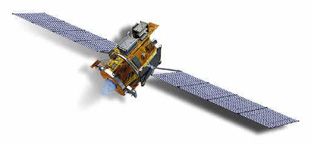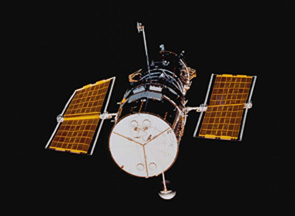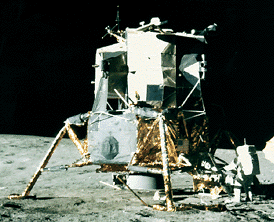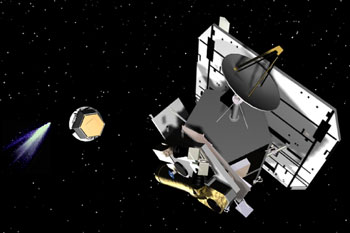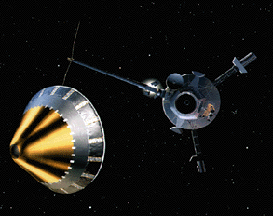Click on image for full size
Image courtesy of NASA
NASA Tests New Technologies with Deep Space 1
NASA launched Deep Space 1 on October 15, 1998. Deep Space 1 tested twelve new technologies, including an ion propulsion drive and an artificial intelligence navigation system. In testing the new equipment, it flew past the Near-Earth Asteroid Braille. Since everything went so well during the first two years of the mission, the mission was extended to include a fly-by of Comet Borrelly in September 2001. Deep Space 1 took the best images ever taken of a comet during this fly-by!The spacecraft, Deep Space 1, was the first launch from NASA's New Millennium program, a program that is testing new technology with the hopes of making space travel easier and more affordable. "Deep Space 1 is taking the risks so that future missions don't have to," said Marc Rayman, chief engineer and deputy mission manager at the Jet Propulsion Laboratory.
The engines on Deep Space 1 used solar energy to ionize xenon gas. The ionized xenon gas was then accelerated through an electric field to speeds of 65,000 mph. The thrust exerted was less force than the weight of a single piece of paper. Still, this was enough to accelerate the spacecraft about 20 mph each day. Since there isn't air resistance in the vacuum of space, the speed continued to build. Ion-propulsion engines are ten times more efficient than regular rockets engines. While normal rocket engines operate on the order of minutes, the ion engine operates on the order of weeks.
Deep Space 1 also controlled its own destiny, in a manner of speaking. It had an onboard navigation system which could locate stars and calculate its position, rather than relying on ground operators to tell it where it was.
The Deep Space mission came to a close on December 18, 2001. Deep Space 1 was definitely another success in space missions!


